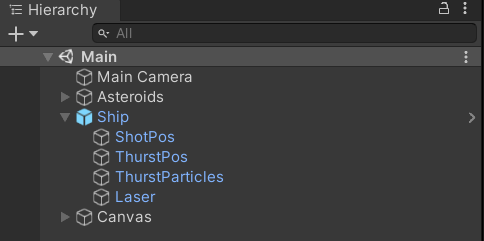Unity Basics 2. Unity's building blocks
2. Unity’s building blocks
Building Blocks
- Unity games consist of Scenes
- Scenes consist of GameObjects
- GameObjects consist of Components
Scenes
- Manual: Scenes
- Scene is a container for content
- A game can be just one scene, or a combination of multiple ones
- Example scenes:
- Main Menu
- Level
- Game Over
- Create New Scene: Assets > Create > Scene
- New scenes use Unity’s default Scene template, but you can create your own
GameObjects
- Manual: GameObjects
- Pretty much everything in Unity is a GameObject
- Fundamental objects in Unity that represent characters, props and scenery
- Some examples…
GameObject Hierarchy

- GameObjects can have multiple child GameObjects $\Rightarrow$ they become parents
- Children inherit their parent’s…
- position
- rotation
- scale
- activeness
- Manual: Hierarchy: Parenting
- Manual: Transform: Parenting
- Note: Rotating child GameObjects can have wonky results if parent has any other scale than $(1,1,1)$.
Components
- Manual: Components
- GameObjects act as containers for Components that implement various functionalities
- GameObject’s components and their settings are listed in the Inspector window
Some important components
- Transform
- Manual: Transform
- position, rotation, scale
- parenting information
- included in every GameObject
Interacting with other GameObjects
- RigidBody
- Manual: RigidBody
- for interacting with the physics engine
- can receive forces and torque
- Collider
- Manual: BoxCollider
- enables collision with other GameObjects
- there are different shapes and sizes
- CapsuleCollider(2D), BoxCollider(2D), PolygonCollider2D…
isTrigger
- ✅ -> Collider is ignored by the physics engine, but can trigger events
Drawing the GameObject
- MeshFilter
- The mesh, or the 3d geometry of a GameObject
- Renderer
- Manual: MeshRenderer
- The component for drawing the GameObject on screen
- MeshRenderer, SpriteRenderer, LineRenderer, TrailRenderer…
- Material
Custom Functionality
